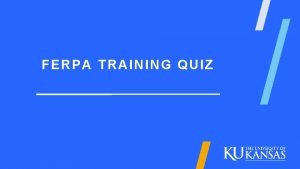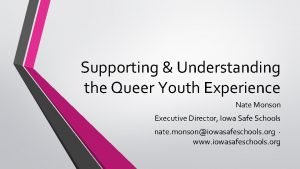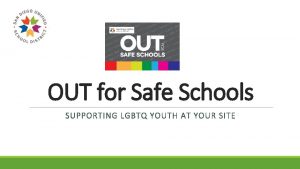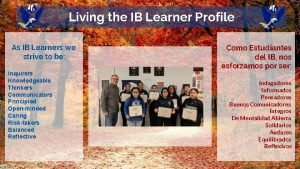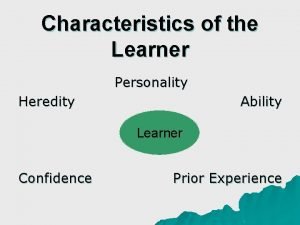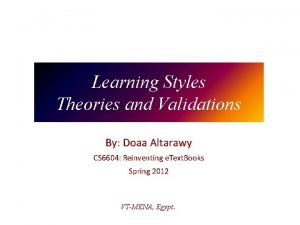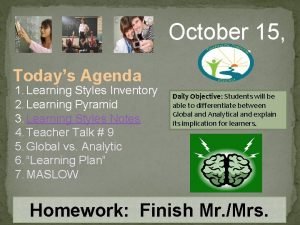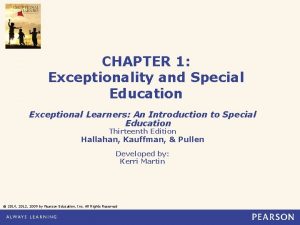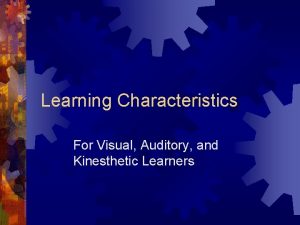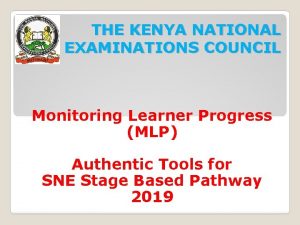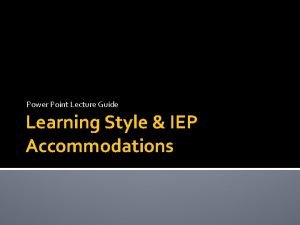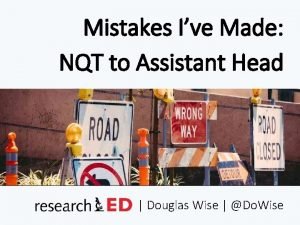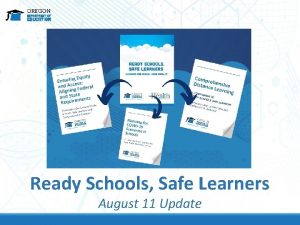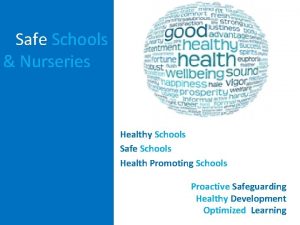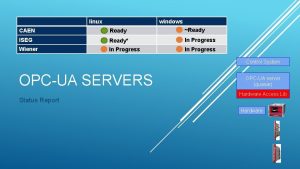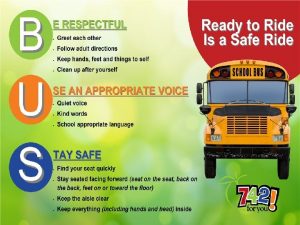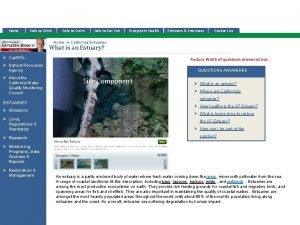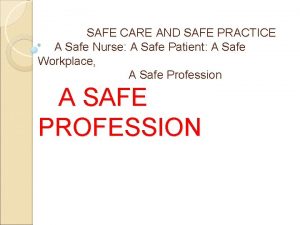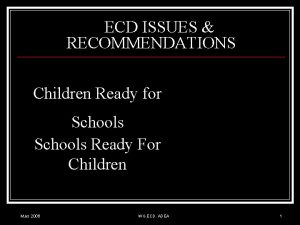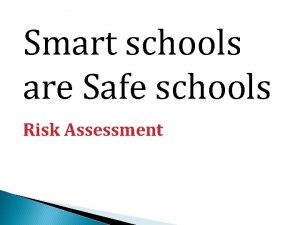Ready Schools Safe Learners July 22 Update July































- Slides: 31

Ready Schools, Safe Learners July 22 Update

July 22, 2020 2. 7. 2 Major No Major changes to any key design parameters in this iteration of guidance Minor There a number of minor, while still substantial changes. All changes are in the Release Notes at the front of the document Patch We found a number of corrections and places to clarify or make the guidance more consistent

When you can't change the direction of the wind – adjust your sails

Guiding Principles • Ensure safety and wellness • Cultivate connection and relationship • Center Equity • Innovate

General Updates

Bigger Picture Policy Framework Ready Schools, Safe Learners returns to decentralized decisionmaking with clear and evolving health and safety and instructional parameters. Guidance With the authority and responsibility of Governor Brown’s Executive Order 20 -29, ODE and OHA provide detailed requirements and recommendations for K-12 schools and related programs. Implementation ODE offers support and coordination at state and regional levels while school, health, and community leaders do the hard work of putting into action their own values and strategies to ensure safety and education for students within the context of the guidance and framework.

Summary of Major Changes ● ● ● Clarifying roles and authorities Cohorting Parameters Face coverings Enrollment Attendance Instructional Time

Clarifying Roles and Authorities Decisions about when or how schools need to respond to an outbreak of COVID-19 involve collaboration across multiple jurisdictions. If part or an entire school needs to close to in-person instruction and transition from On-Site or Hybrid Instructional models to Distance Learning models as a matter of public health, it is also important that educators, students, families, and the general public have a clear understanding of how decisions are made and who makes those decisions. (pg. 10)

Key Practices

Cohorting Parameters Cohorts help manage risks in the potential spread of COVID-19. In particular, the size of the cohort matters for risk management. Student cohorting: (1) limits the number of exposed people when a COVID-19 case is identified in the school, (2) quickly identifies exposed individuals when a COVID-19 case is identified, (3) minimizes school-wide disruptions in student learning. (pg. 23) ● Students cannot be part of any single cohort, or part of multiple cohorts that exceed a total of 100 people within the educational week. Schools should plan to limit cohort sizes to allow for efficient contacttracing and minimal risk for exposure. ● A smaller cohort size of 24 -36 is recommended for public health and safety.

Face Coverings Face coverings are now required for all students in grades kindergarten and above along with all staff. Certain accommodations are noted in the guidance. . . (pg. 26) Students who abstain from wearing a face covering, or students whose families determine the student will not wear a face covering, during On -Site instruction must be provided access to instruction. Comprehensive Distance Learning may be an option, however additional provisions apply to students protected under ADA and IDEA.

Face Coverings and Accommodations No disability category universally prescribes whether a student will be able to wear a face covering. However, students eligible for certain disability categories are more likely to have difficulty wearing face coverings. These include: Autism Spectrum Disorder, Other Health Impairment, Emotional Behavior Disability, Orthopedic Impairment. Schools must consider the unique needs that arise from a student’s disability in determining how to appropriately support their access to FAPE.

Enrollment processes support strong school operations and are needed for the financial allocations of the State School Fund. For the 2020 -21 school year, ODE plans to suspend the “ 10 -day drop”, pending approval of the State Board of Education, with the expectation that a student will only be unenrolled when a school or district has received notice that they’ve been enrolled in another setting. (pg. 31)

Attendance For On-Site Instructional Models, prior attendance and reporting practices are unchanged and should meet the requirements described in this section and can be informed by the recommendations presented. For any Hybrid Instructional Model or Comprehensive Distance Learning, ODE is establishing the following definitions and guidance: ● Attendance includes both participation in class activities and interaction with a licensed or registered teacher during a school day or interactions with educational assistants and paraprofessionals through teacher designed and facilitated processes. ● Interaction can be evidenced by any of the following or reasonable equivalents: ○ Participating in a video class; ○ Communication from the student to the teacher via chat, text message or email; ○ A phone call with the student, or, for younger students, with the parent; ○ Posting completed coursework to a learning management system or web-based platform or via email; or ○ Turning in completed coursework on a given day. ● When there is no evidence of student interaction during a 24 -hour period surrounding a scheduled school day as described, students are reported as absent. A day present for attendance may not be claimed for weekends or holidays, per ORS 336. 010 and 187. 010, or any other day during which a licensed or registered teacher is not available to students.

Instructional Time As we work to prioritize student learning in the coming school year, a common approach to instructional time requirements that apply across every instructional model and to every public school district, public charter school, and virtual public charter school are critical. (pg. 47) For students not attending in-person through the On-Site Instructional Model, at least 50% of instructional time (as defined above) must meet the criteria for teacher-facilitated learning.

Learning Day Overview Grade Level K-3 4 -8 9 -11 12** Teacher- Facilitated Learning* (Daily/Weekly) Applied Learning Nutrition and Wellness (snack, lunch, rest, connect, time management) Must account for at least 50% of Instructional Time Must not account for more than 50% of Instructional Time Does not count for Instructional Time 2 hours, 20 minutes per day 11 hours, 40 minutes per week (Required Minimum) Daily/weekly Daily 2 hours recommended 2 hours, 30 minutes per day 12 hours, 30 minutes per week (Required Minimum) 2 hours, 50 minutes per day 14 hours, 10 minutes per week (Required Minimum) 2 hours, 45 minutes per day 13 hours, 45 minutes per week (Required Minimum) No Required Minimum Daily/weekly No Required Minimum Daily 2 hours recommended *Based on 165 day school year and a 5 -day week (50% calculation based on dedicated instructional hours in Division 22; recess, professional development, and parent/teacher conference allowance was subtracted prior to the calculation) ** Twelfth-graders typically follow established daily high school schedules, but end their school year earlier than students in Grade 9 -11

Minor Changes ● Clarification on bus driver use of face shields or masks when driving. ● New content on Drivers Education programs. ● Clarifying guidance on student engagement, attendance, and enrollment across all three instructional models. ● New content for K-12 Residential Programs (Boarding Schools). ● Clarity on how staff should maintain physical distance, eat, and use staff rooms. ● Additional info from OHA on extent of isolation when cohort member tests positive ● Prioritize needs of students with Credit Assurance plans ● Clarification and preview on future guidance for Hybrid Models. ● Integration of feedback from school nurses. ● Updated requirements for staying home when staff or students have symptoms and positive test. ● Supporting well-rounded education activities while mitigating risk ● Updated language on physical distancing to maintain six feet between individuals ● Added language about promoting mental health and staff awareness of student social and emotional states ● Updates to Assessment, Grading, and Reporting for CDL and Hybrid

Instructional and Extracurricular Activities Requiring Additional Consideration Beyond the general considerations outlined above there are program specific guidelines that will help administrators and educators plan for classes requiring additional considerations. Use the linked guides to develop implementation plans. ● Career and Technical Education ● Laboratories ● Visual and Performing Arts ● Physical Education ● Driver Education

New Support Tools

Comprehensive Distance Learning

Considerations on CDL ● Implementation implications for setting an intentional and higher quality standard for distance learning, including resource, infrastructure, and professional learning needs for communities in the state unable to meet those standards if required to move into CDL overtime even if not their initial reopening plan. ● Expectations for engagement, attendance, and instructional time. ● The majority of each student’s services under ESSA, ADA, or IDEA must be provided synchronously (i. e. , with the teacher/service provider and student working together through direct, simultaneous communication). The amount of instruction that is synchronous vs. asynchronous is determined locally by each school and district, but should overwhelmingly lean towards a synchronous nature. This is best when included in inclusive virtual settings using synchronous instruction. ● Implications of CDL guidance for Hybrid Instructional Models.


Steps of Plan Submission Preparation 1. Read this Ready Schools, Safe Learners guidance in its entirety. 2. Consult your Local Public Health Authority and familiarize yourself with the disease management metrics within your health region. Schools with attendance boundaries within more than one county may need to consult multiple local public health authorities. 3. Assemble appropriate personnel within the school/district, including teachers and any community partners to create a planning team.

Steps of Plan Submission Plan Development 4. Work with the planning team to complete the Operational Blueprint template for your school. This must include a plan for all settings in the school, such as preschool and EI/ECSE classrooms or community transition programs which may be housed in other locations. Private schools are required to complete sections 1 -3. 5. Consult with key partners (see section six, including Tribal Consultation) to complete the Operational Blueprint for Reentry. 6. Submit the Operational Blueprint for Reentry to your local school board.

Steps of Plan Submission Public Health Review 7. Submit the Operational Blueprint for Reentry to your Local Public Health Authority. a. Public school districts, ESDs, and public charter schools should compile all the school blueprints at the district level. The district should then submit the blueprints to the appropriate LPHA for each school site. School district and ESD boundaries sometimes overlap LPHA (typically county) boundaries. School districts and ESDs may be submitting plans to more than one LPHA based on the location of each school in their district. b. State Sponsored public charter schools should submit directly to the LPHA. c. Private schools that are part of a system of schools (E. g. Catholic schools) should compile all the school blueprints at the system level. The system operator should then submit the blueprints to the appropriate LPHA for each school site. Private school system boundaries sometimes overlap LPHA (typically county) boundaries. Private school systems may be submitting plans to more than one LPHA based on the location of each school in their district. d. Private schools that operate as a single school entity should submit directly to the LPHA. 8. Your Local Public Health Authority will attest to receiving the blueprint, naming that the LPHA will be reviewing sections 1 -3, and that the LPHA stands ready to work together with the school to mitigate impacts from COVID-19.

Steps of Plan Submission Final Plan Submission 9. Post the Operational Blueprint for Reentry on your school and district websites. If there is no school or district website, it can be posted to the ESD website. 10. Submit links to the final plan(s) for each school to the Oregon Department of Education.

Send your link to ODE

Governor’s Healthy Schools Reopening Council Guidance Development Work in Progress ODE is working on a number of smaller and larger pieces of additional guidance, clarification, and support tools. Some will be released sooner than August 11. ● Guidance on Athletics and Activities ● Companion guidance for advancing equity and legal obligations under IDEA, ADA, and FAPE ● More detailed guidance for Hybrid Instructional Models. ● Health and Safety Indicators that can inform or direct what instructional models schools should select ● Common Protocols for responding to outbreaks ● New content on practicing Safety Drills safely

Governor’s Healthy Schools Reopening Council Guidance Development Work in Progress ODE , OHA, and the Governor’s Office are working on a set of COVID-19 impact and healthcare readiness criteria to guide you in your instructional model decision. This should be released in the next few days. ● Current COVID-19 Impact: ○ Case Rates per 100, 000 in population over time ○ Test positivity rates ● Local readiness for: ○ Contact tracing ○ Testing ○ Hospital capacity/PPE availability

Grace & Patience We are learning together to move powerfully on behalf of children and communities.

Questions. . .
 Is an alternative of log based recovery.
Is an alternative of log based recovery. Stay ready to keep from getting ready
Stay ready to keep from getting ready Ready respectful safe assembly
Ready respectful safe assembly Safe feed safe food
Safe feed safe food Safe people safe places
Safe people safe places Safe schools ferpa answers
Safe schools ferpa answers Nate monson iowa safe schools
Nate monson iowa safe schools Out for safe schools badge
Out for safe schools badge Safety reach target
Safety reach target Huntsville cs powerschool
Huntsville cs powerschool Kinesthetic learning
Kinesthetic learning Ib learners profile
Ib learners profile Rigor and relevance quadrants
Rigor and relevance quadrants Learners will be able to
Learners will be able to Inheritance characteristics
Inheritance characteristics Technology for diverse learners
Technology for diverse learners Impulsive learners
Impulsive learners Remedial teaching is employed to
Remedial teaching is employed to Reading strategies for english language learners
Reading strategies for english language learners Involuntary attention meaning
Involuntary attention meaning When is cognitivism beneficial for learners
When is cognitivism beneficial for learners Cr part 154
Cr part 154 Global vs analytical learners
Global vs analytical learners English language learners
English language learners Government program for gifted students in the philippines
Government program for gifted students in the philippines Exceptional learners: an introduction to special education
Exceptional learners: an introduction to special education Characteristics of a kinesthetic learner
Characteristics of a kinesthetic learner Knec mlp
Knec mlp Active and passive learners
Active and passive learners Global vs analytical learners
Global vs analytical learners Graham nuttall the hidden lives of learners
Graham nuttall the hidden lives of learners 3b using questioning and discussion techniques
3b using questioning and discussion techniques





